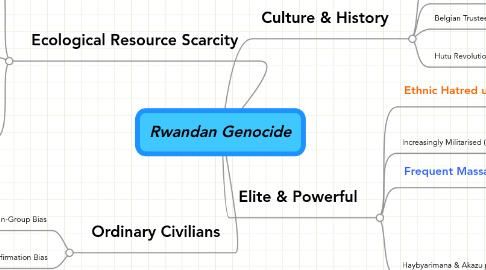
1. Ecological Resource Scarcity
1.1. Large Population (most populated African country)
1.2. Economic Crises
1.2.1. Agricultural Crisis
1.2.1.1. Effects from Civil War (1991 onwards)
1.2.1.2. Plant Disease (1988)
1.2.1.3. Drought (1884)
1.2.1.4. Excessive Rain (1987)
1.2.2. Drop in International coffee and tea prices
1.2.3. Increase of Government to the Civil War effort (38% of budget in 1992)
1.3. Highest Growth Rate in Africa
2. Ordinary Civilians
2.1. In-Group Bias
2.1.1. Propoganda
2.1.2. Use Out-Group as Scapegoat
2.2. Confirmation Bias
2.2.1. Staged Shootings
3. Elite & Powerful
3.1. Ethnic Hatred used to unite the majority of population
3.1.1. Propoganda
3.1.2. Extremist Political Parties Created - preached hatred & violence
3.1.3. Extension of RPF threat to all Tutsi
3.1.3.1. Staged Shootings
3.2. Increasingly Militarised (increase from 5000 to 40000)
3.3. Frequent Massacres of Tutsi (since the Civil war)
3.4. Haybyarimana & Akazu power was threatened by factors
3.4.1. Rural Protest
3.4.2. Economic Crisis
3.4.3. Structural Adjustment
3.4.4. Internal Political Discontent
3.4.5. RPF Invasion
3.4.6. International Pressure
4. Culture & History
4.1. King Rwabugiri (1860-1895) favoured Tutsi
4.2. German Colonisation (1899-1916) favoured Tutsi
4.3. Belgian Trusteeship (1916-1961) favoured Tutsi
4.3.1. Increased Ethnic Identity by issuing ID cards
4.4. Hutu Revolution (1959-1961)
4.4.1. Thousands of Tutsi went into exile
4.4.2. Series of mass killings (1964-1994)
